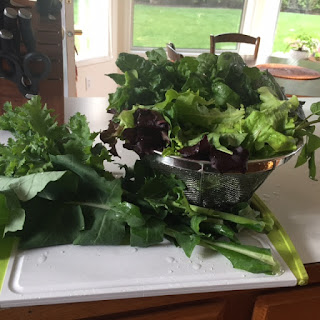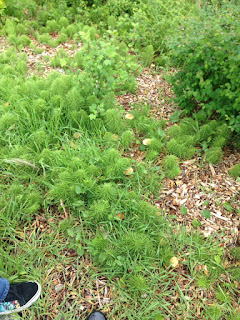Service Learning Essay
Naomi Eguchi Faletti 6/12/17
Campus Community Farm for two hours: May 8, 2017, 3pm-5pm.
Sponsor: EDCC
Edmonds Campus Community Farm raises organic vegetables,
edible trees, shrubs, bee-loving flowers, and plants with the idea of maintaining
a self-sustainable garden. Through the use of earthworms, honey bees, organic
compost, onions around the garden for insects repellent, 1000 lady bugs, wine
bottles to retain heat around the garden are just to name a few of the techniques used to help the garden be
self-sustainable.
My role was to pull weeds in the garden so that vegetables
and fruit had enough space to grow and receive plenty of sun. Without interruption of weeds to take the
nutrients from the soil around them the garden plants could thrive. I also harvested vegetables for the college
café to use the next day. At the end, we could take kale, beets, leek, onion,
lettuce, spinach, rosemary, rhubarb, cilantro, and sage home for or own use.
My vegetarian Professor, Gwen from the Marine Bio class : )
The Service Learning activity at the Community Farm made me
realize when an ecosystem is functioning in fine balance, the garden can
self-sustain without pesticide. When plants produce healthy harvest, they help
support each other along with other species to maintain a healthy balance. A garden
full of lady bugs, earthworms, and onions all around it uses symbiotic
relationships to work the ecosystem. This use of science at the farm collaborated
with volunteer efforts to remove invasive plants to establish a truly native
environment. Along with well drain soil created by irrigation, rain guards,
watersheds, the Community Farm does not require pesticides to maintain nutrient
rich and beautiful produce. The vegetables I took home from the harvest on that
day were very tasty; it actually tasted sweet and almost did not need dressing
to enjoy for dinner. It was very satisfying and I still had some left for next
few days in the refrigerator but they all stayed fresh as if it was just
harvested. The learning activity illustrates that even in an urban setting a
farm-to-table environment to complement your diet can be established. This has
great potential in the Pacific Northwest bioregion as less land is available to
grow local produce.
The experience at the garden reminded me of starfish wasting
syndrome that we studied in class. Starfishes are very susceptible to
temperature, pH level, and virus according to marine biologists. Starfishes are easily effected by environmental
changes. As a keystone species, the wide spread death of Starfishes can effect
ecosystem in the ocean. The same can happen at the Community Farm. The plants
we saw were positively interacting with each other in ideal conditions. The Garden
had all the great features to self-sustain. The combination of plants and
insects indicates they are living in a symbiotic relationship. Because of the
class learning, my mind was set as a citizen scientist with keen eyes to
monitor and understand the phenomenon to compare and contrast the Community
Farm with a marine ecosystem. What I took from this experience was Marine
Biology and Farming is both interdisciplinary. There is no difference between
land and ocean when it comes to an ecosystem; each requires balance to remain
self-sustaining.
How are irrigation systems designed and developed?
How do irrigation systems work and what is the expense?
How does a rain garden work and what is the expense to
build?
How do we know what insects would work to eliminate other
pests on certain plants?
Why does the Community Farm have almost no bugs on the
plants?
We weigh the harvest after washing and register on the log
It was my dinner at home : ) Very healthy and tasty!





Comments
Post a Comment